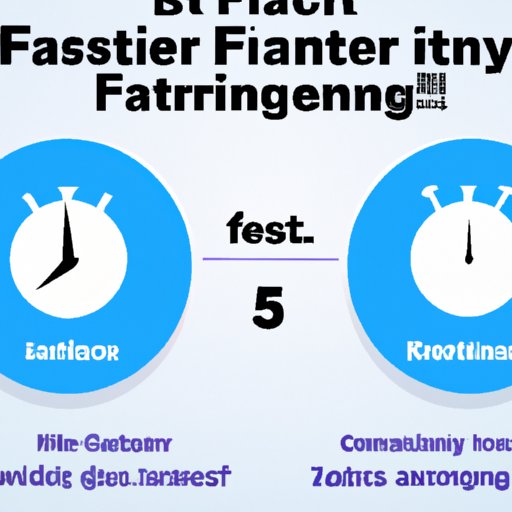
I. Introduction
Intermittent fasting is a popular health trend that involves alternating between periods of eating and periods of fasting. This eating pattern has gained popularity among health enthusiasts for its many health benefits, including weight loss, improved metabolism and insulin sensitivity, and reduced inflammation. In this article, we will explore the different types of intermittent fasting, the benefits of intermittent fasting, what to eat and drink during intermittent fasting, how to deal with hunger pangs, and some frequently asked questions about this eating pattern.
II. Benefits of Intermittent Fasting and Why You Should Try It
There are many health benefits associated with intermittent fasting, including:
- Weight loss
- Improved metabolic health
- Reduced inflammation
- Lowered risk of certain diseases, such as type 2 diabetes and cardiovascular disease
Recent scientific studies have also shown that intermittent fasting can have several other benefits for the body, including promoting cellular repair and reducing oxidative stress. These benefits, in turn, may help improve overall health and increase lifespan.
III. What is Intermittent Fasting and How to Get Started?
Intermittent fasting is an eating pattern that involves alternating between periods of eating and periods of fasting. This can be done in a variety of ways, such as restricting your daily food intake to a certain number of hours or eating normally for a few days a week and reducing calorie intake on other days.
If you are new to intermittent fasting, it is best to start slowly and gradually ease into the fasting routine. For example, you could start by skipping breakfast and extending your overnight fast by a few hours. As you become more comfortable, you can increase the length of your fasts.
IV. 5 Popular Intermittent Fasting Methods and How to Choose Which One’s Right for You
There are several different types of intermittent fasting, including:
- 16/8 method
- 5:2 diet
- Alternate-day fasting
- 24-hour fasts
- 36-hour fasts
The 16/8 method involves restricting your daily food intake to an 8-hour window and fasting for the remaining 16 hours. The 5:2 diet involves eating normally for five days of the week and reducing calorie intake to 500-600 calories on two other days. Alternate-day fasting involves fasting every other day, while 24-hour and 36-hour fasts involve going without food for a full day or two, respectively.
The best intermittent fasting method for you depends on your lifestyle and personal preferences. Some people may find it easier to fast for shorter periods of time, while others may prefer longer fasting periods. It is also important to choose a method that fits in with your daily routine and allows you to still eat a healthy, balanced diet.
V. What to Eat and Drink During Intermittent Fasting
During the eating phase of intermittent fasting, it is important to consume a healthy, balanced diet that includes plenty of protein, fiber, and healthy fats. It is also important to stay hydrated by drinking plenty of water and electrolyte-rich fluids such as coconut water or bone broth.
To break your fast, it is recommended to eat a protein-rich meal that can help to replenish your energy levels and support muscle growth and repair. Some good options include grilled chicken or fish, eggs, and leafy green salads with plenty of veggies.
VI. How to Deal with Hunger Pangs During the Fasting Period
When you are fasting, you may experience hunger pangs or cravings for food. To help alleviate these symptoms, it is important to drink plenty of fluids, such as water or tea, which can help to fill your stomach and keep you full. You can also try keeping yourself busy with other activities, such as reading, going for a walk, or doing yoga.
If you still feel hungry, it is okay to snack on healthy foods such as nuts, seeds, or raw veggies, as long as you do not exceed your daily calorie limit.
VII. Frequently Asked Questions About Intermittent Fasting
Some common questions about intermittent fasting include:
Can you exercise during a fast?
Yes, it is possible to exercise during a fast. However, it is recommended to choose low-intensity workouts such as yoga or walking rather than high-intensity activities such as weightlifting or running.
Is intermittent fasting safe for diabetics?
Intermittent fasting can be safe for people with diabetes, but they should talk to their doctor first as it may affect their blood sugar levels and require adjustments to insulin doses.
VIII. The Do’s and Don’ts of Intermittent Fasting: Tips and Tricks for Success
Some tips to keep in mind when starting intermittent fasting include:
- Listen to your body and start slowly
- Stick to a consistent fasting routine
- Stay hydrated and consume electrolyte-rich fluids
- Eat a healthy, balanced diet during your eating phase
- Avoid overeating or binging during the eating phase
IX. Conclusion
Intermittent fasting is a popular and effective way to improve overall health and wellbeing. By following a consistent fasting routine and consuming a healthy, balanced diet during the eating phase, you can reap the many benefits of this eating pattern. If you are interested in trying intermittent fasting, start slowly and listen to your body, and don’t hesitate to consult a healthcare professional if you have any concerns.




